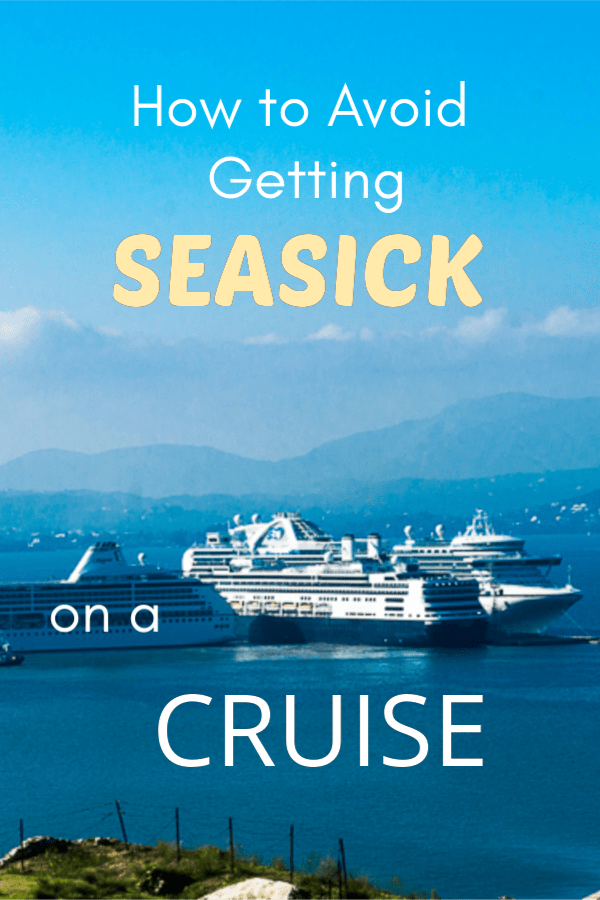What's the number one reason some people will never set foot on a cruise ship or ferry? They want to avoid motion sickness and know that the best way to avoid getting seasick is to avoid traveling over water.
Fortunately, technology has improved over the years. Cruise ships are more stable than ever and research has found new ways to avoid getting seasick and keep you ship-shape (sorry, couldn't resist that pun). So we have collected the newest and best tips for making sure you can keep your food down on the high seas and enjoy every minute of your vacation.

What are the symptoms of approaching seasickness?
God forbid, but even those with the right frame of mind can get queasy. Early signs and symptoms of motion sickness usually begin with:
- chills
- dizziness
- increased saliva production
- frequent burping
- headache
- fatigue

Why do people get seasick?
Here's how it works: Balance and equilibrium are controlled in the inner ear. Motion sickness is caused when your inner ear senses motion that your eyes don't detect. When your ears sense things are moving but they look like they are still, the conflicting messages can stress on your brain. Result: nausea sets in.
If you're one of the vacationers who have experienced the headache, nausea, stomach cramps and vomiting that come with seasickness, you can agree: It's misery. Those symptoms may not make you die, but motion sickness can make you almost wish you could.
ⓘ TIP: If you have never tested your sea legs, try a 2-3 night weekend getaway to see how your body reacts.
How can you avoid getting seasick?
Here's the good news: You can prevent seasickness. It may take a few days to get your “sea legs,” but after you do, the symptoms will go away completely.
Now is the time to try as many of these remedies as you can. The sooner you take action, the less chance you'll experience full-blown seasickness.
1. Choose the right cruise.
Choosing the right itinerary is essential. If you are sensitive to motion, look for an itinerary that offers more ports. You want fewer days at sea and more days in port with an opportunity to get off the ship and onto terra firma.
Two or more days at sea is not ideal if you are sensitive to motion. If you sail the open seas (e.g. trans-Atlantic or -Pacific), you should expect to encounter a lot more movement. Waves can be high, thanks to weather fronts and changes in ocean temperatures.
As a rule, smaller bodies of water have fewer high waves than you'll find in the open ocean.
Best ocean cruise itineraries to avoid getting seasick:
- Caribbean
- Mediterranean
- Alaska inside passage
- River cruises
ⓘ RELATED: 10 Adriatic Cruise Ports You Need to Visit and 24 Reasons to Take a River Cruise

2. Choose the right time of year.
Bottom line: With the exception of the Caribbean or Mexico (which are warm year-round), those end-of-season sailings can be more rough.
Autumn sailings to Alaska, the Pacific Northwest, the Mediterranean, Northern Europe, and South America often experience choppy seas due to the approaching cold weather. Spring and autumn sailings on the West Coast are also often rough.

3. Choose the right ship.
Newer ships have special, state-of-the-art stabilizers that help keep the ship from rocking. Larger ships are more stable as well. Think about it: It is harder to toss around a 1,100-foot-long mega-cruise ship than a 2-man fishing boat.
That said, don’t worry about bad weather. Captains usually try to avoid storms, and apart from when you leave the dock, you will rarely even notice that the ship is moving, especially when the weather is nice.

4. Choose the right cabin.
This is where booking far in advance really pays off, because you’ll have lots of rooms to choose from.
- Avoid an interior cabin. When you are inside, your eyes are telling your brain there is no movement even while the inner ear is telling the brain there is. Result: nausea. Looking out at the horizon will help reorient your sense of balance (and your stomach).
- Get a cabin with a balcony or window that opens. Fresh air will help if you start to feel sick.
- Request a cabin in the middle of the ship. The forward and aft of the ship will have the most movement (especially the front), so the middle of the ship will feel less of these extremes.
- Choose a room near the water line. As a rule, you will feel more movement on the higher floors of the ship. Picking the lowest available cabin that offers a balcony might be a great compromise.
ⓘ TIP: A few cruise lines offer “sheltered balcony” staterooms on lower floors.

5. Buy an anti-nausea treatment before setting sail.
If you have been prone to motion sickness in the past, a little advance preparation can make all the difference. You can find both natural and pharmaceutical ways to avoid getting seasick, so choose your favorite health approach.
Regardless of which antiemetic you choose, it's unlikely you'll find the one you want on board. So take your pick and bring them with you!
- Over-the-counter anti-nausea medications. The most popular drugs that combat motion sickness include Dramamine, Marezine, Bonine, Phenergan, and Sea-Calm. We prefer meclizine (generic Bonine) because it is chewable, lasts for 12 hours and doesn’t make us drowsy. That said, you should always consult with your doctor before trying any medications, just to make sure that there won't be any adverse reactions. That would completely ruin your cruise! We buy our meclizine on Amazon.
- Prescription medications. While we don't recommend pharmaceuticals as a rule, your doctor can prescribe something for you if you're particularly sensitive to motion. Options are oral, rectal and transdermal, so take your pick. One of the most widely recommended used is Transderm Scop. which you wear behind the ear.
- Homeopathic medications. We don't understand how homeopathic medications actually work but, after using one that helps us avoid jet lag, we're believers. We've not tried it yet, but Hyland's Motion Sickness Relief tablets get good reviews.
- Aromatherapy. A number of essential oils that help calm an upset stomach on long car rides or other motion. You can try peppermint, cardamom, ginger root, or a synergistic blend of oils. Consider a blend like this one.
- Plant therapy. According to one book, there are a 101 plants that are reported to help cure seasickness. Please don't try them all at once.
- ReliefBand. ReliefBand is an FDA-cleared device that has been clinically proven to stop nausea and vomiting from motion & morning sickness. It uses “neuromodulation” to stimulate the nervous system with electrical impulses. Buy it on Amazon.
- Acupressure. Traditional Chinese Medicine holds that applying pressure to certain points can relieve medical problems in other areas. Try applying pressure to the middle of the inner forearm 2½ finger widths above the wrist crease. It is said to relieve nausea, indigestion, stomach aches, and wrist pain.
But let's face it: It’s impractical to do acupressure for very long. Result: someone invented acupressure wrist bands. Your mileage may vary, but some people can even read in a moving car with them on.
ⓘ TIP: You can find a list of acupressure bands at the end of this article. Or search Amazon now using this link.
6. Stay out of the cabin.
Okay, you've chosen the right cabin, but don't spend much time there. When you are inside a cabin on a ship, your eyes are telling your brain there is no movement, while at the same time your inner ear is conveying that there is motion. These confusing messages are what causes seasickness.
You can reset your equilibrium by looking at the horizon. This will bring your eyes and ears into alignment, which will signal the brain that everything is all right. You can either go outside on an open deck or balcony, or sit near a large window.
ⓘ TIP: Use the stairs to reach another floor, rather than an elevator. Sometimes, enclosed spaces can enhance disequilibrium.

7. Use the pool.
Some people swear that swimming underwater gives immediate relief. This may have something to do with the water equalizing the pressure in your ears.
If your ship has a pool, you can also try floating in the water. This is because your legs will no longer need to balance with the roll of the ship. Divers have been known to get seasick too, so this may or may not work. Still, it's worth a try.

8. Be nice to your body.
Don't stress your body, and it won't stress you. Here are some tummy-friendly suggestions:
- Look out over the forward part of the ship. This helps many people get acclimated to the motion of the ship in the water and helps to train the brain to stop the nausea.
- Get as much fresh air as possible.
- Steer clear of places with strong odors.
- Stay hydrated. Drink plenty of water.
- Get some exercise, either at the gym or on deck.

9. Be kind to your stomach, too.
Yes, we know: Cruise lines are notorious for abundant food. Still, that doesn’t mean you need to overindulge in them. Keep your meals light and easy to digest. When your body is stressed, your stomach produces acid that can upset it even more.
- Go easy on the alcohol. if you think seasickness is misery, imagine how bad it would be if coupled with a mild hangover.
- Keep something in your stomach. (Good thing: it’s never hard to find food on a cruise ship!)
- Avoid fatty foods.
- Go for carbs, like popcorn, crackers or dry cereal. They help soak up stomach acid.
- Skip super spicy foods.
- Also, avoid the seafood buffet. Ironically, shellfish is often a culprit.

10. Don't expect to get seasick.
The mind is a powerful thing, and so is the power of suggestion. Hence the term “mind over matter.”
If you board the ship expecting that you will get seasick, your expectations can increase the chances that you will. Similarly, if you have experienced motion sickness (car, train, plane) in the past, memories of those experiences can affect you.
Anxiety contributes to seasickness as well, so try to relax. It might be easier said than done, but find ways to distract yourself and stay busy on the ship as much as you can. Enjoy the on board entertainment, take a class, hop in the pool, go sunbathing, read a book.
After all. you are on vacation. Right?
ⓘ TIP: It may help to know that it is a common experience to have seasickness on one cruise, but not another. So the past does not always foretell the future.

How to get over seasickness once you have it
Here's what to do if you can't avoid feeling sick.
1. Head outdoors.
Stand on deck. Breathe the fresh air. Stare at the horizon. Regardless of the ship’s movement, focusing on the straight horizon does wonders to stop queasiness.
2. Try getting in the pool.
As long as the seas aren't rough, the pool's water will stay level. Floating in the pool will help to balance your inner ear.
3. Try acupressure.
Use your fingers to press harder on acupressure points. Or, if you had removed your seasick bands for whatever reason, put them back on.
4. Eat something.
Get a little food in your stomach … but don’t eat too much. Avoid anything greasy, spicy or acidic. The best foods are light and bland, Try:
- Dry foods such as saltine crackers, plain bread, or pretzels. (It's been a traditional help for morning sickness for centuries.)
- Ginger. Ask the dining room's Maître d’ if the kitchen has any candied ginger. Or stop at the sushi bar and ask for a few slices of ginger. Sipping on ginger ale can also work – as long as it contains real ginger, not just ginger flavoring. Also, if ear pressure is to blame (see #7 above), perhaps the repetitive motion of chewing works best. You can also try ginger gum or ginger candy to relieve symptoms.
- Mint. Both peppermint candy and mint tea help to settle the stomach when you are getting seasick.
- Green apples. We’ve never tried them but have heard they help keep seasickness at bay.
- Have a Coke. It contains phosphoric acid and sugar, two of the same ingredients you'll find in Emetrol, an over-the-counter anti-nausea drug. Some also say that any carbonated beverage works, but that ginger beer works best.
Resources to help you avoid getting seasick
Prepare ahead with these helpful links.
Essential oils
As we mentioned, some essential oils are known to help with nausea. You can buy them at natural food stores and on websites like Amazon and iHerb.
Acupressure bands
These work in a variety of ways:
- Manual – Wrist bands are available at local pharmacies and online. Sea-Band is the best-known brand. Get them on Amazon.
- Magnetic – Magnetic Therapy bands
- Electrical – Reliefband delivers an electrical pulse instead of pressure.
Save to Pinterest and don't forget to share our story with your cruise-loving friends.
Books
Amazon has a book entitled How to Avoid Vomiting: P-MAV Manual: Peterson Method to Avoid Vomiting (Sea Sickness and Motion Sickness).
If you find others, please let us know.
Inspired? Pin this post and share it with your friends!





Linda an exceptional blog on cruise, I wanted to go for cruise for atleast a week & this blog actually gives me a lot on information about how to hadle the sea sickness & thanks for the wonderful article
I’m glad it was helpful.
Thank you for this post, Linda! One of my dreams is to go on a cruise for at least 7-8 days. I’m going to refer to this post whenever I book a cruise for myself. You know, in fact, I was imagining myself on a cruise with my husband while reading this article. 🙂
You’re welcome, Renuka! I do hope you and your husband decide to take a cruise, because it’s a fabulous experience.
Linda these tips are sensational. I recall boating from Koh Lanta to Phuket as low season began to set in. Pretty high seas in the Andaman. Simply being with a little discomfort allowed the feelings to pass. Taking care of your body makes sense; caring for it strengthens it, making you less prone to any sickness.
Thanks for the positive vibes, Ryan. I had to share this because I’m often prone to motion sickness. You were wise not to focus on the feelings. In my experience, that only makes it worse.